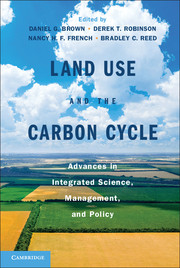Book contents
- Frontmatter
- Contents
- Chapter Authors and Affiliations
- Acknowledgments
- Acronyms
- Part I Introduction
- Part II Measurement and Modeling
- 5 Remote Sensing for Mapping and Modeling of Land-Based Carbon Flux and Storage
- 6 Atmospheric Observations and Inverse Modeling Approaches for Identifying Geographical Sources and Sinks of Carbon
- 7 Limitations, Challenges, and Solutions to Integrating Carbon Dynamics with Land-Use Models
- 8 Modeling for Integrating Science and Management
- Part III Integrated Science and Research Applications
- Part IV Land Policy, Management, and the Carbon Cycle
- Part V Synthesis and Future Directions
- Index
- Plate Section
- References
6 - Atmospheric Observations and Inverse Modeling Approaches for Identifying Geographical Sources and Sinks of Carbon
Published online by Cambridge University Press: 05 February 2013
- Frontmatter
- Contents
- Chapter Authors and Affiliations
- Acknowledgments
- Acronyms
- Part I Introduction
- Part II Measurement and Modeling
- 5 Remote Sensing for Mapping and Modeling of Land-Based Carbon Flux and Storage
- 6 Atmospheric Observations and Inverse Modeling Approaches for Identifying Geographical Sources and Sinks of Carbon
- 7 Limitations, Challenges, and Solutions to Integrating Carbon Dynamics with Land-Use Models
- 8 Modeling for Integrating Science and Management
- Part III Integrated Science and Research Applications
- Part IV Land Policy, Management, and the Carbon Cycle
- Part V Synthesis and Future Directions
- Index
- Plate Section
- References
Summary
Introduction
Identifying the geographic distribution of sources (i.e., emissions, efflux) and sinks (i.e., uptake, sequestration) of carbon (C), as well as the temporal variability in these C fluxes, is important for a variety of reasons. These include (1) improving the current understanding of the global C cycle and the processes controlling flux variability, (2) using this increased understanding to improve the ability to predict how the C cycle will evolve under future climate conditions, and (3) evaluating the effectiveness of C management strategies aimed at either reducing emissions or increasing C uptake.
A complicating factor in understanding the spatial and temporal distribution of C fluxes is the fact that these fluxes cannot be observed directly at scales beyond one or several square kilometers. C fluxes can be measured directly in the laboratory at very fine scales, and eddy covariance flux observations, such as those provided by the FLUXNET (e.g., Baldocchi et al. 2001) and AmeriFlux (e.g., Hargrove, Hoffman, and Law 2003) networks can be used to directly infer C fluxes with footprints of approximately 1 km2, depending on site characteristics (e.g., see Chapter 10). To understand C fluxes and their controlling processes at climate- and policy-relevant scales, however, estimates of flux ranging from ecoregion to global scales are needed.
- Type
- Chapter
- Information
- Land Use and the Carbon CycleAdvances in Integrated Science, Management, and Policy, pp. 144 - 177Publisher: Cambridge University PressPrint publication year: 2013
References
- 1
- Cited by

